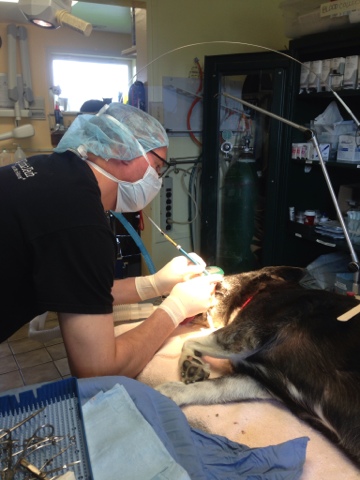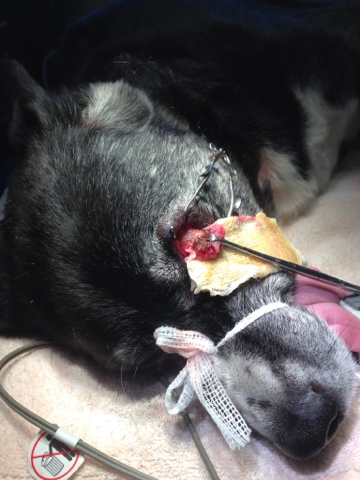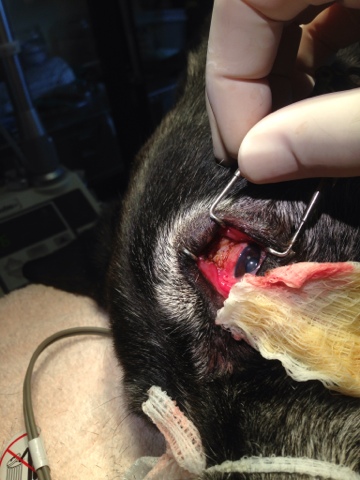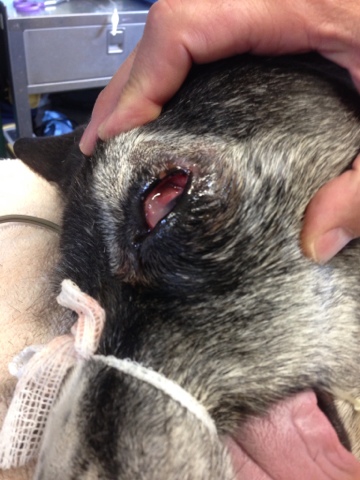This is Dallas. He is a twelve year old lab mix who has lived at Animal Rescue since the day they found him. That day was about eleven years ago. He is a lifer. He will very likely die in the one place he has ever known as home. Now, I do not say this to ask you to feel sorry for him. Although many of us believe that a real home with parents and your own yard and the full flight of affection being doled only to you is the ultimate guardianship experience, Dallas is happy, loved, and at home he shares with about a thousand other four legged friends.
Dallas developed a slight swelling of his left upper eyelid a few months ago. Over that time the swelling has progressed and the eye was being irritated significantly each time he blinked. The consequence of irritation on your eye? profuse yellow-green discharge.
He was brought to a veterinarian who recommended a biopsy to determine the identity of the mass.
So Dallas was placed under general anesthesia and a small sliver of the fleshy soft conjunctival mass was shaved off and submitted to a lab.
Here's where my goat gets a little ruffled. You ask any vet what they think this is and they will ALL say, "cancer."
AND, here is where I need to add a BIG GIANT disclaimer. Medicine is always a delicate dance of "should do's," and "can-do's." What is optimal is not always feasible, for more reasons than I have the strength to list.
You ask any vet who works for a rescue what they would do about it and they will ALL say, "in a twelve year old lab that has never left the rescue I would take that mass off and keep him happy and comfortable for the remainder of the days he has left."
To not take as much, or all, of that mass off at the first surgery, is infuriating for me to think about.
Dallas, came to me because he still had a huge, annoying, ugly mass on his eyelid. Only difference this week, it had a name 'adenocarcinoma.' AKA, cancer, AND, he had just been through general anesthesia a week ago.
(Note; in all pets, especially older pets; minimize the number of anesthetic events to as few as possible. Anesthesia has its own inherent risks, it is an immuno-suppressive, it lowers/weakens your immune systems ability to fight off disease and illness, and it can 'turn-on' cancer cells).
The rescue came to us because we have a laser. The laser allows us to cut tissue quickly and with minimal bleeding, hugely important when you are trying to remove a soft, friable, fleshy, fragile skinless grape from under an eyelid.
The other huge advantage; it cuts like butter, and about as fast as a hot knife through it.
And in less than five minutes Dallas got a new eyelid.
For those of us who try to live and practice by the gold standard there are problems with our quick fix:
- Clean margins. These are how we know that we removed the whole tumor in its entirety. This is done by submitting the mass to a pathologist for microscopic evaluation. Without clean margins there is a much higher chance that the tumor will come back.
- Additional surgeries would have been required to try to get clean margins because Dallas would have needed his entire upper eyelid removed. A flap would have had to have been advanced from the skin on his head, or side of his face, to reconstruct the top eyelid. The problem with this is the eyelid margins. This is the area of skin without hair that allows you to blink without sweeping a row of lashes/hair across your delicate and sensitive cornea.
Dallas did wonderfully through his surgery. His eye looks great and he has no further discharge or swelling.
He is still looking for his own home, but blinking and seeing comfortably in the home he has spent his whole long healthy life in.
Here is my take away advice from Dallas' story. Talk about every aspect of your pets treatment plan. Discuss long term and short term risks and benefits. Surgery has inherent risks, and often it is hard to try to guess prognosis without a diagnosis, but each case has its own set of circumstances to guide all parties through the twists and turns of their particular case. Make decisions based on thinking, discussing, and deciding on what is best for all parties. Try to not make them based on fear. I know this is hard to do, but don't avoid potentially life saving or quality of life decisions because YOU are too afraid to try. I see this too often in private practice. Pet parents not making a decision because they are crippled by the fears of what-if.
If you have any questions about anything pet related please find me on Pawbly.











No comments:
Post a Comment